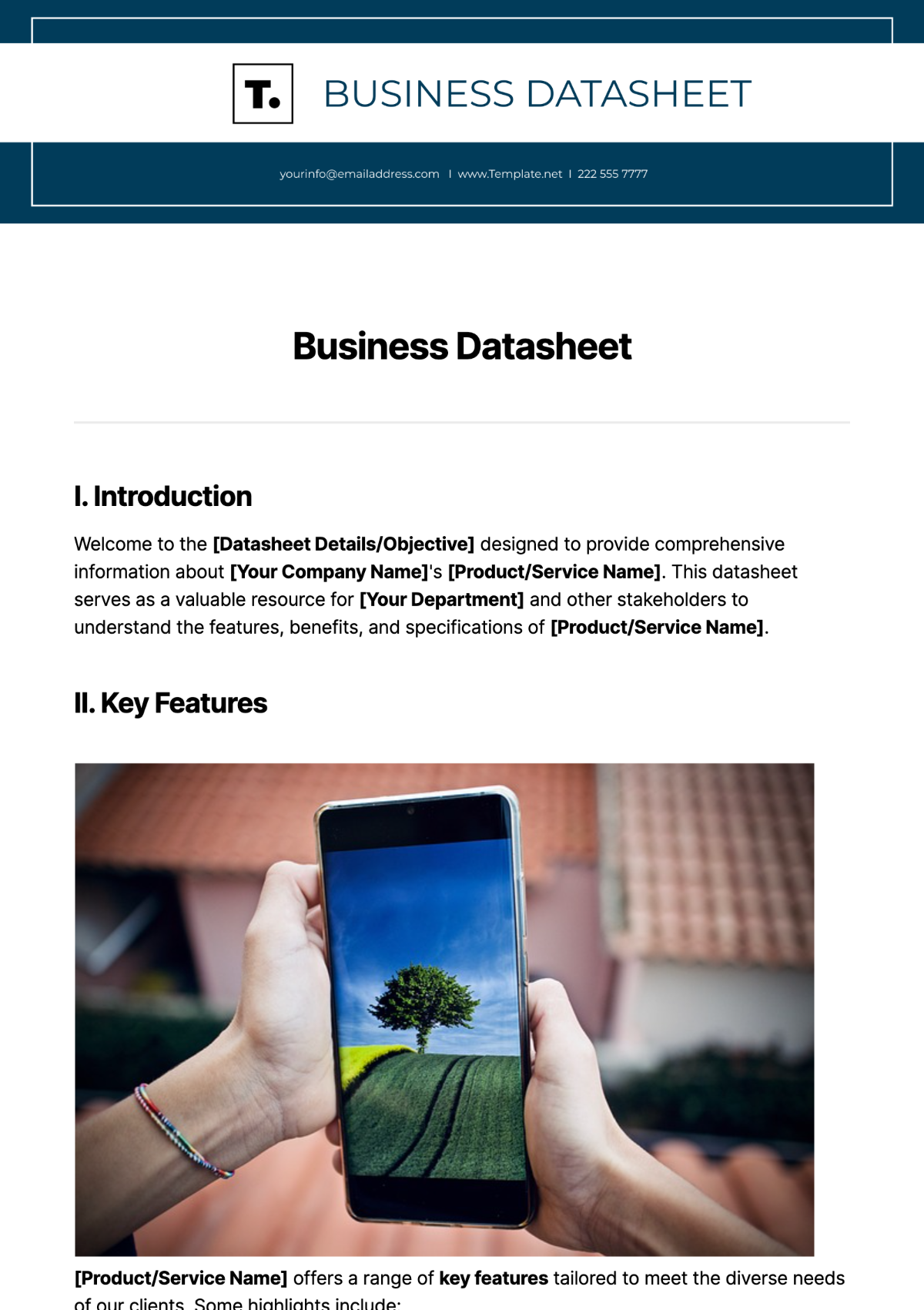Business Support and Maintenance
Prepared by | Date Prepared |
|---|---|
[YOUR NAME] | [DATE] |
Department | Company |
[YOUR DEPARTMENT] | [YOUR COMPANY NAME] |
I. Scope
The Scope of our support extends to providing holistic assistance, maintenance, and upkeep to an array of technical products and systems. These systems range from software applications and hardware equipment to a variety of tech assets. We assure full-time service and dedicated personnel for meeting support and maintenance requirements. Our team is hands-on to ensure smooth functioning and prolonged service of your technical tools. We stay updated with the latest technology to provide the best possible solutions.
II. Objectives
Provide comprehensive technical support and maintenance services for various products and systems.
Extend quick and efficient resolution to all tech-related issues.
Ensure systematic update and maintenance of all technical tools.
Provide well-equipped, competent, and professional personnel for support and maintenance services.
Aim for customer satisfaction through exceptional service.
III. Roles and Responsibilities
Roles | Responsibilities |
|---|---|
Technical Support Specialist | Responds to incoming queries, diagnosing and troubleshooting technical issues, and providing ongoing customer support. |
Maintenance Analyst | Audits and maintains systems regularly, checking performance and resolving issues. |
System Administrator | Manages and maintains server infrastructure, including installation, configuration, and optimization. |
Network Engineer | Designs, implements, and maintains network infrastructure, ensuring connectivity and security. |
Software Developer | Develops, tests, and maintains software applications, including bug fixes and updates. |
Quality Assurance Tester | Tests software applications and systems to ensure functionality, performance, and reliability. |
Database Administrator | Designs, implements, and maintains databases, ensuring data integrity, security, and availability. |
Cybersecurity Analyst | Monitors and analyzes security threats, implements security measures, and responds to security incidents. |
IT Project Manager | Plans, coordinates, and oversees IT projects, ensuring they are completed on time and within budget. |
Technical Trainer | Develops and delivers training programs for end-users and support staff, ensuring they are proficient in using technical tools and systems. |
IV. Support Channels
Our support channels are designed to provide comprehensive assistance and accessibility to our customers. You can reach out to us through various mediums, ensuring that your technical issues are addressed promptly and efficiently.
Email: [YOUR COMPANY EMAIL]
Send detailed descriptions of your technical issues or inquiries via email, and our support team will respond promptly to assist you.
Phone: [YOUR COMPANY NUMBER]
Contact our dedicated support hotline for immediate assistance with urgent technical matters. Our knowledgeable support staff are available to provide guidance and solutions over the phone.
Live Chat: [YOUR COMPANY WEBSITE]
Engage in real-time conversations with our support representatives through our website's live chat feature. Get instant answers to your questions and receive guidance on troubleshooting technical issues.
Self-Service portal: [YOUR COMPANY WEBSITE]
Access our self-service portal on our website to find helpful resources, such as knowledge base articles, FAQs, and troubleshooting guides. Empower yourself to resolve common technical issues independently at your convenience.
Social Media: Facebook, Twitter, LinkedIn
Connect with us on social media platforms for updates, announcements, and community discussions. Reach out to our support team through direct messages or comments for assistance with technical inquiries or feedback.
Our diverse array of support channels ensures that you can choose the communication method that best suits your preferences and needs. Whether you prefer direct interaction with a support agent or self-service options, we are committed to providing timely and effective assistance to resolve your technical challenges.
V. Response Times
At [Your Company Name], we understand the urgency of resolving technical issues promptly to minimize disruption to your operations. Our commitment to exceptional service is reflected in our response times, ensuring that your concerns are addressed in a timely manner.
Immediate Issues: We prioritize immediate issues with utmost urgency, aiming to provide assistance within 30 minutes of your report. Your critical needs are our top priority, and we're dedicated to swiftly resolving them to keep your business running smoothly.
High Priority: For issues that require urgent attention but may not be as time-sensitive as immediate concerns, expect a response within 1 hour. We strive to address high-priority issues promptly to prevent any potential impact on your productivity.
Medium Priority: Issues categorized as medium priority will receive our attention within 4 hours. While not as urgent as immediate or high-priority matters, we understand the importance of timely resolution to maintain the efficiency of your operations.
Low Priority: Even low-priority issues are not overlooked. We commit to addressing these concerns within 24 hours to ensure that all your technical needs are met, regardless of their urgency.
Requests for Information: If you have inquiries or requests for information, we aim to provide a comprehensive response within 2 business days. We value your inquiries and strive to furnish you with the information you need in a timely manner.
With our responsive support team and clear prioritization system, you can trust [Your Company Name] to be there for you when you need us most. Your satisfaction and operational continuity are our top priorities, and we're dedicated to exceeding your expectations with our timely and effective assistance.
VI. Issue Resolution Process
Navigating through technical challenges requires a systematic approach to ensure swift and effective resolution. At [Your Company Name], we adhere to a structured issue resolution process that prioritizes clarity, efficiency, and customer satisfaction.
Identify the Issue: The journey to resolution begins with a thorough understanding of the problem at hand. Our skilled support team diligently analyzes reported issues, gathering all necessary details to accurately pinpoint the root cause.
Classify and Prioritize the Issue: Not all issues are created equal, which is why we employ a robust classification system to categorize each problem based on its severity and impact. By prioritizing effectively, we ensure that critical issues receive immediate attention while addressing less urgent matters in due course.
Assign the Issue to Respective Support Personnel: Once classified, the issue is swiftly assigned to the appropriate member of our support team. Our experts are handpicked for their specialized skills, ensuring that each problem is handled by the most qualified individual.
Resolve the Issue and Validate the Solution with End-Users: Armed with expertise and dedication, our support personnel embark on the journey to resolution. Through meticulous troubleshooting and problem-solving, they work tirelessly to implement effective solutions. Before concluding the process, we validate the solution with you, ensuring that it meets your expectations and resolves the issue satisfactorily.
Document the Solution for Future Reference: The journey doesn't end with resolution – we believe in equipping ourselves for future challenges. Every solution implemented is carefully documented for future reference, enriching our knowledge base and empowering us to tackle similar issues with ease in the future.
VII. Maintenance Procedure
Maintenance Procedure | Purpose |
|---|---|
Regular audits | Conduct comprehensive assessments of technical systems and hardware to identify potential issues, ensure optimal performance, and preemptively address any emerging concerns. |
Scheduled updates | Implement timely updates to software, firmware, and system configurations to enhance functionality, patch security vulnerabilities, and improve system stability. |
Thorough hardware cleaning | Perform systematic cleaning of hardware components to remove dust, debris, and contaminants, thereby preventing overheating, reducing wear and tear, and extending component lifespan. |
Hardware repair/replacement | Address faulty or failing hardware components through repair or replacement procedures to restore functionality, minimize downtime, and maintain system integrity. |
Backup and recovery | Establish regular backup protocols and exercises to safeguard critical data, applications, and configurations, ensuring rapid recovery in the event of data loss or system failure. |
VIII. Change Management
Change management is a pivotal component of our support and maintenance framework, ensuring a seamless evolution of your systems. We adopt a proactive approach to manage changes, from minor adjustments to transformative overhauls, with a meticulous process that encompasses screening, design, testing, implementation, and review.
Feasibility Screening
Conduct a comprehensive assessment of proposed changes to evaluate their feasibility.
Consider potential impacts on system functionality, performance, and security.
Collaborate with relevant stakeholders to gather insights and expectations.
Design
Develop a detailed plan outlining the scope, objectives, and technical requirements of the proposed changes.
Collaborate with our technical experts to create a blueprint that ensures a seamless integration of the changes into the existing system.
Testing
Implement rigorous testing protocols to validate the functionality and stability of the proposed changes.
Conduct simulated scenarios to identify and address potential issues before implementation.
Ensure compatibility with existing systems and applications.
Implementation
Execute the approved changes following a carefully planned timeline to minimize disruption.
Collaborate with your team to coordinate and communicate the implementation process effectively.
Monitor the changes in real-time and address any unforeseen issues promptly.
Review for Effectiveness
Post-implementation, conduct a thorough review to assess the impact and effectiveness of the changes.
Solicit feedback from end-users and stakeholders to gauge user experience and system performance.
Identify areas for improvement and implement necessary adjustments.
Our change management process is not just about adapting to technological shifts; it's about optimizing our offerings to enhance service delivery. By embracing change with a strategic and well-defined approach, we ensure that your systems evolve seamlessly, meeting the demands of the dynamic technological landscape while maintaining a high standard of service excellence.
IX. Training
Training Material/Resources | Availability | Description |
|---|---|---|
User manuals | Available on support portal | Comprehensive guides covering system functionalities, troubleshooting, procedures, and best practices. |
Training videos | Available on support portal and YouTube channel | Visual tutorials covering various aspects of system usage, configuration, and optimization. |
Live training sessions/ Webinars | Scheduled as per demand/ necessity | Interactive sessions conducted by our expert trainers, tailored to address specific user needs and queries. |
Knowledge base articles | Accessible via support portal | Extensive library of articles offering in-depth insights, tips, and solutions for common technical challenges. |
Online courses | Available on e-learning platforms | Structured courses covering advanced topics and specialized skills, offering self-paced learning opportunities. |
Hands-on workshops | Conducted periodically | Practical sessions providing hands-on experience with system features, configurations, and troubleshooting. |
X. Reporting and Monitoring
Our reporting and monitoring framework ensures complete visibility of the support and maintenance landscape. We maintain extensive and meticulous logs of every complaint, issue, resolution, change, or update, which allows us to offer transparency and, at the same time, gather valuable insights. Reports are made available monthly to senior management and stakeholders so that they can monitor service level agreement compliance and performance metrics.
Furthermore, we utilize state-of-the-art monitoring tools to keep track of system health and troubleshoot in real-time. We believe in proactively identifying and resolving issues before they affect business operations. Every change, every untoward incident, and every resolution is recorded and maintained in a central database, assisting in trend analysis, forecasting, and decision-making for service optimization. This vigilance forms the backbone of our commitment toward offering impeccable technical support and maintenance services.
Support and Maintenance Templates @ Template.net

















































